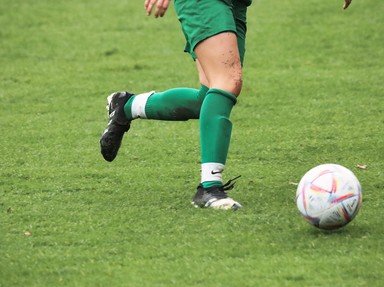Quiz Answer Key and Fun Facts
1. Except for "deliberately handling the ball", a penal foul (punished by a direct free kick) must necessarily involve contact with an opponent (the opponent's equipment, such as his jersey, is included in the meaning of "contact").
2. A direct free kick has been awarded to the defense on their own penalty mark (Note: this is not a penalty kick). An opponent is standing inside the penalty arc, just outside the penalty area, when the kick is taken. The ball comes outside the penalty area, deflects off this opponent, and into the defending goal. Assuming the field is properly marked, what is the proper restart of play?
3. An attacking player, who is in his opponent's half of the pitch, is in an offside position when, at that moment, his teammate, who is in his own half of the pitch, plays a lateral (or "square") pass across the pitch. The first attacking player runs back into his own half of the pitch, and there he receives the pass. Is this an offside offense?
4. A dropped ball is to be taken outside the defending team's goal. The referee, in what will be the blunder of his career and comical fodder for news tabloids for weeks to come, drops the ball on his own toe, which then takes a bounce on the ground, before meandering into the goal of the defense. What is the proper restart of play?
5. The defending team has been awarded a throw-in in their own half of the pitch. The player taking the throw decides to throw the ball back to his own goalkeeper, and on its way to the keeper, takes an unfortunate bounce and is headed towards an open goal. The keeper dives at the ball and punches it (outside the goal area, but inside the penalty area) but to no avail: the ball enters the defender's goal anyway. Also, the assistant referee has his flag up, indicating the throw-in was illegally taken. What is the correct restart?
6. An attacking player in possession of the ball is moving quickly towards his opponent's goal, being chased down by only one defender. This defender, in realizing he is about to be passed, puts out a leg in an attempt to trip the attacker (the ball is obviously not within playing distance). The attacker simultaneously falls to the ground, and play is stopped on account of this. However, the assistant referee closest to the play indicates that he saw no actual contact between the attacker and the pursuing defender; he claims the attacker is guilty of simulation (diving). What is the proper course of action for the referee?
7. Play is occurring in the defender's penalty area. A defender is knocked to the ground inside the penalty area (not as a result of illegal contact) and places two hands on the ground to brace himself for the fall. After the defender falls to the ground, an attacker in possession of the ball deliberately kicks the ball into the hand of the fallen defender, and the ball deflects off this hand and back to the feet of the attacker. What is the proper course of action for the referee?
8. Play is happening in the attacking end of the field. An attacker is standing in an onside position level with the second to last opponent (the goalkeeper in this instance) waiting for an attacking opportunity. As the ball is about to be passed to him, the last defender, as a part of normal play, leaves the field of play over his own goal line, and not even a second later, the ball is played forward to the attacker by his teammate, who is now standing beside the last opponent (still the goalkeeper) on the field of play. The attacker receives the ball and puts it into the goal. Is this a properly scored goal?
9. Play is happening in the attacking end of the field. As an attacker is about to take a shot on goal with no defense in his way (including the goalkeeper) a substitute of the defending team, who is standing off the field of play, throws an object at the attacker before he can take his shot at goal. The attacker is knocked down and play is stopped. After sending off the substitute for violent conduct, what is the proper restart?
10. A corner kick is being taken by the attacking team (redundant, I guess). The ball is kicked into play and gets lost in a sea of players. At this time, an attacker, whose back is to the play and to the ball, is given a two-handed push by a defender and falls to the ground backwards. He puts his hands down to brace for the impact, when the ball finds a way out of the sea of players towards the falling attacker. Still unable to see the ball, the motionless arm of the attacker deflects the ball into the goal. The defender who pushed the attacker is sent off for serious foul play. What is the restart of play?
Source: Author
crazychessman
This quiz was reviewed by FunTrivia editor
Nightmare before going online.
Any errors found in FunTrivia content are routinely corrected through our feedback system.
